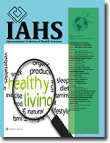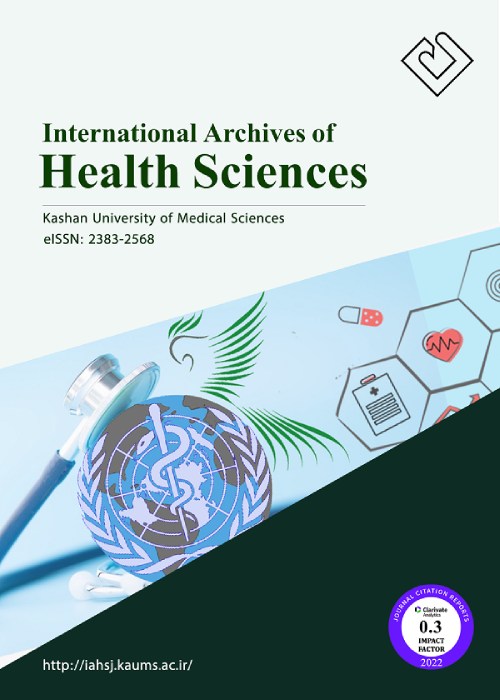فهرست مطالب

International Archives of Health Sciences
Volume:9 Issue: 3, Jul-Sep 2022
- تاریخ انتشار: 1401/05/08
- تعداد عناوین: 5
-
-
Pages 107-110Aims
The use of automatic teller machines (ATMs) daily has increased the chances of hand‑borne transmission of microorganisms to the machine’s surfaces, and they can have an important role in microorganisms’ transmission to individuals. This study aimed to investigate microbial contamination in ATMs in the center of Iran.
Materials and MethodsThis cross‑sectional study was used to collect samples from the keyboards and monitors of the ATMs in Kashan. After 24 h of incubation, the swabs were inoculated on different selective media, including MacConkey agar and blood agar. Microbiological tests were used to confirm bacterial isolates.
ResultsThe most frequently contaminated ATMs were government banks, with 69% contamination. The most frequently isolated bacterium was Staphylococcus epidermidis) 37/77%). The other bacteria were also identified, including Bacillus spp. (17/77%), Escherichia coli (7/77%), Micrococcus spp. (7/77%), Myroides odoratus (4/44%), Klebsiella pneumoniae (2/22%), Staphylococcus aureus (2/22%), Staphylococcus saprophyticus (1/11%), and Klebsiella oxytoca (1/11%), respectively.
ConclusionsThe most tested ATM keyboards in this study were contaminated with at least one microorganism. According to our results, it is recommendable to disinfect the hands after entering public places to hinder the spread of critical pathogens.
Keywords: Automated teller machines, bacteria, diseases, Kashan, keyboard -
Pages 111-116Aim
Management of COVID‑19 is an issue of concern around the world. Several factors and strategies influence COVID‑19 crisis management in every country. This study aimed at assessing the status, the trend of incidence rate changes, and the factors affecting it during 4 months.
Materials and MethodsThis assessment was carried out simultaneously in three fields – care, monitoring, and managerial support. The method of implementing the plan in the cities was in the form of segmenting the city based on neighborhood, district, region, and city. Interventions were assessed by collecting information from the other two sections and citing valid information about the intended consequences, including death, hospitalization, infection, and other outputs. The information of the identified patients was extracted by census based on the patient care records in the cities of the province and analyzed using SPSS 16.
ResultsThe mean and standard deviation of the death age was 69.12 ± 19.91 years. 60.8 of the deaths (15105) were in males and the rest were in females. In Iran, the trend of the corona epidemic increased until October 2020 and included about 500 deaths/day but with the implementation of this plan, the mortality rate decreased.
ConclusionConsidering the effectiveness of this plan, it is hoped that by strengthening the disease care system and more supervision in implementing the strategy and having an effective relationship with private section physicians to comply with the national protocol, an effective step was taken to control this disease and finally eliminate it.
Keywords: Control, COVID‑19, Iran, neighborhood‑based prevention approach -
Pages 117-122Aims
To compare online video and pamphlet education in improving the knowledge of high school students toward COVID and to assess satisfaction with the two educational approaches.
Materials and MethodsIn this randomized controlled trial, 240 girl students received either online, video‑based education or pamphlet‑based education or that described the methods of dealing with COVID‑19 and description of COVID‑19 symptoms as well as a control group that received no intervention. Their knowledge was assessed at baseline and 12 weeks after group‑specific intervention.
ResultsParticipants in both groups had similar levels of baseline knowledge. Poststudy analysis showed significantly greater improvement in the knowledge scores from video group members compared to the pamphlet group (P = 0.003). Both pamphlet and video groups significantly achieved better scores than the control group (P < 0.001). Finally, the video group rated their education method more useful and appealing than the pamphlet group (P = 0.018).
ConclusionVideo‑based learning is a more effective educational tool for teaching methods of preventing and transmitting of coronavirus disease than written materials.
Keywords: COVID‑19, education, knowledge, pamphlet, video -
Pages 123-128Aims
The purpose of this study is the analysis of bibliometric studies of the medical most‑cited papers.
Materials and MethodsThis applied and the scientometric study was conducted using retrospective bibliometric analysis methods. A Scopus search was conducted and 883 articles were retrieved. After reviewing the titles and abstracts, 432 articles related to the purpose of this research were identified. Items such as year, journal, country, and institution were considered. Medical subject heading and NLM were applied for the subject categorization of articles. Given the dynamics of subject areas over time, only the content of 117 articles published in 2020 and 2021 were analyzed. These 117 articles have been reviewed with 11,700 most‑cited articles. By reviewing 117 articles, the most productive journal, country, and institute in producing 11,700 articles were identified.
ResultsThe findings have shown a significant number of these publications review 100 most‑cited articles in the field of medicine. Articles pertaining to the Nervous System, Musculoskeletal System, Dentistry, Radiology, and Cardiovascular System are the most numerous among the publications.
ConclusionThe results of this study allow readers to know the most productive countries, institutions, and journals of various subject areas, as well as the most influential fields and research trends in that subject area. The results of this study also identify subject areas for which the characteristics of their core articles have not yet been explored to plan future research.
Keywords: Bibliometric, biomedical research, medicine in literature -
Pages 129-134Aims
Klebsiella pneumoniae is an important cause of nosocomial infections. The present study sought to detect resistance status and the frequency of multidrug‑resistant (MDR), extensively drug‑resistant (XDR), and pandrug‑resistant (PDR) K. pneumoniae strains isolated from hospitalized patients.
Materials and MethodsConfirmation of K. pneumoniae isolates was performed by polymerase chain reaction (PCR) for rpoB fragment. Drug susceptibility was done by disk diffusion method based on the Clinical and Laboratory Standards Institute. According to the susceptibility pattern, the strains were categorized as MDR, XDR, and PDR.
ResultsOn the basis of PCR results, rpoB gene was identified in all 100 K. pneumoniae isolates. Most K. pneumoniae strains showed a high percentage of resistance against ampicillin‑sulbactam (93%). On the other hand, tigecycline and fosfomycin were active against 100% and 90% isolates, respectively. The multiple resistance analysis of the strains showed that 58% and 13% of isolates were identified as MDR and XDR, respectively. Overall, no PDR isolate was detected in any tested strains.
ConclusionOur results demonstrated that the vast majority of K. pneumoniae strains indicated the MDR phenotype including a high resistance rate to common antibiotics. Therefore, it is suggested to implement antimicrobial susceptibility testing before prescribing, to assist in selecting the most effective agents within the antimicrobial categories for the treatment of infections with multiple antibiotic‑resistant K. pneumoniae strains in hospitalized patients.
Keywords: Extensively drug‑resistant, fosfomycin, Klebsiella pneumoniae, multidrug‑resistant, nosocomial infections


